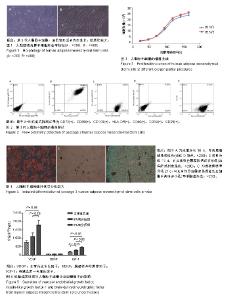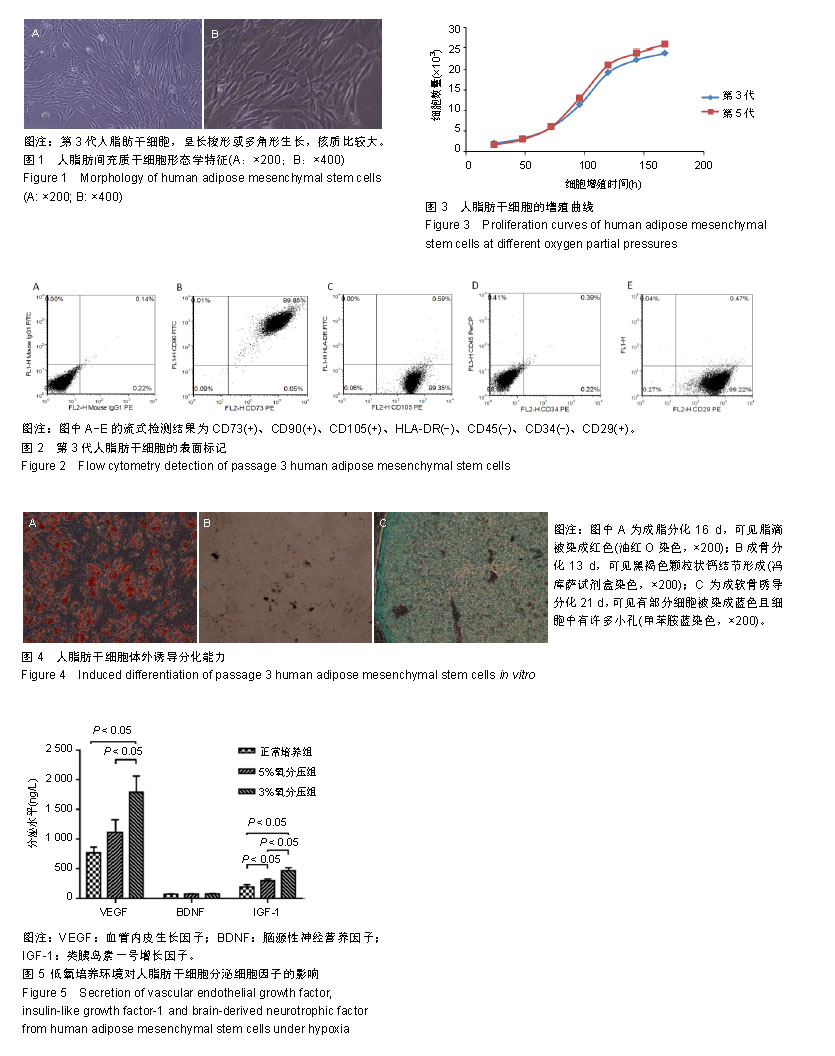Chinese Journal of Tissue Engineering Research ›› 2019, Vol. 23 ›› Issue (29): 4681-4687.doi: 10.3969/j.issn.2095-4344.1814
Previous Articles Next Articles
The secretion levels of various cytokines in human adipose mesenchymal stem cells under hypoxia
Wang Qian1, Liu Yi2, Zhang Yu3, Yang Yinxiang1, Wang Zhaoyan1, Zhang Leping1, Luan Zuo1
- 1Department of Pediatrics, The Sixth Medical Center of PLA General Hospital, Beijing 100048, China; 2Department of Pediatrics, The First Medical Center of PLA General Hospital, Beijing 100039, China; 3Department of Neonates, Beijing Obstetrics and Gynecology Hospital, Capital Medical University, Beijing 100026, China
-
Revised:2019-05-20Online:2019-10-18Published:2019-10-18 -
Contact:Luan Zuo, Master, Chief physician, Department of Pediatrics, The Sixth Medical Center of PLA General Hospital, Beijing 100048, China -
About author:Wang Qian, Technologist-in- charge, Department of Pediatrics, The Sixth Medical Center of PLA General Hospital, Beijing 100048, China; Liu Yi, Technologist-in- charge, Department of Pediatrics, The First Medical Center of PLA General Hospital, Beijing 100039, China. Wang Qian and Liu Yi contributed equally to this work. -
Supported by:the Military Logistics Research Project, No. CHJ14C022 (to LZ)
CLC Number:
Cite this article
Wang Qian, Liu Yi, Zhang Yu, Yang Yinxiang, Wang Zhaoyan, Zhang Leping, Luan Zuo . The secretion levels of various cytokines in human adipose mesenchymal stem cells under hypoxia[J]. Chinese Journal of Tissue Engineering Research, 2019, 23(29): 4681-4687.
share this article

2.1 人脂肪干细胞的形态变化 倒置显微镜下观察细胞形态,原代培养24 h后可见有少量细胞贴壁生长,培养48 h首次换液,随着培养时间的延长,细胞密度逐渐变为长梭形,72 h后大部分细胞呈长梭形生长,6 d左右细胞融合达80%以上。传代后细胞增殖速度较原代明显加快,4 d即长满瓶底,细胞形态呈长梭形或多角形态,呈漩涡状生长,排列有序,核质比大,见图1。 2.2 人脂肪干细胞表面标记物的鉴定结果 流式细胞仪检测第3代人脂肪干细胞表面标记,细胞阳性表达CD73(99.9%)、CD90(99.86%)、CD105(99.94%)和CD29(99.22%),阴性表达HLA-DR(0.59%)、造血干细胞表面标志CD34(0.61%)和CD45(0.8%),见图2。 2.3 人脂肪干细胞的生长增殖情况 分别绘制第3代、第5代人脂肪干细胞的生长曲线,由图3可见细胞经过了24 h生长停滞期后,第3-5天为迅速生长的对数增殖期,第6-7天增殖速度明显减缓且趋于平稳。第3代、第5代人脂肪干细胞都具有较强的增殖能力,保持了良好的生长趋势,无显著差异。群体倍增时间为(37±2) h。 2.4 人脂肪间充质干细胞成脂、成骨、成软骨诱导和鉴定 ①成脂诱导:加入成脂诱导液培养5 d后可见少量细小的脂滴形成,随着诱导时间延长,脂滴形成逐渐增多,呈现葡萄串珠样。诱导第15天时进行油红O染色,可见脂滴被染成红色,边界清晰,见图4A;②成骨诱导:加入成骨诱导液培养7 d后细胞逐渐停止增殖,诱导21 d后冯库萨染色后可见黑褐色颗粒状钙结节形成,见图4B;③成软骨诱导:诱导分化3周后,细胞团逐步形成一个密实且有弹性的乳白色小球,冰冻切片后进行甲苯胺蓝染色,可见有部分细胞被染成蓝色且细胞中有许多小孔,具有软骨特征,见图4C。 2.5 低氧诱导对脂肪干细胞分泌细胞因子的影响 血管内皮生长因子、类胰岛素一号因子在低氧刺激下分泌量明显增多,各实验组血管内皮生长因子的分泌量差异有显著性意义(P < 0.05);血管内皮生长因子的分泌量在3%氧分压组中显著多于5%氧分压组和正常培养组(P < 0.05)。在5%氧分压组中显著多于正常培养组(P < 0.05)。各实验组类胰岛素一号因子的分泌量差异有显著性意义(P < 0.05),类胰岛素一号因子的分泌量在3%氧分压组、5%氧分压组均显著高于正常培养组,类胰岛素一号因子在3%氧分压组分泌量最高。各实验组脑源性神经营养因子分泌水平差异无显著性意义(P > 0.05),见图5。"

| [1]Wang JM, Gu Y, Pan CJ, et al. Isolation, culture and identification of human adipose-derived stem cells. Exp Ther Med. 2017;13(3):1039-1043.[2]Grudzenski S, Baier S, Ebert A, et al. The effect of adipose tissue-derived stem cells in a middle cerebral artery occlusion stroke model depends on their engraftment rate. Stem Cell Res Ther. 2017;8(1):96.[3]Hsiao ST, Lokmic Z, Peshavariya H, et al. Hypoxic conditioning enhances the angiogenic paracrine activity of human adipose-derived stem cells. Stem Cells Dev. 2013; 22(10):1614-1623.[4]Chung HM, Won CH, Sung JH. Responses of adipose-derived stem cells during hypoxia: enhanced skin-regenerative potential. Expert Opin Biol Ther. 2009;9(12): 1499-1508.[5]Saltzman DJ, Toth A, Tsai AG, et al. Oxygen tension distribution in postcapillary venules in resting skeletal muscle. Am J Physiol Heart Circ Physiol. 2003;285(5):H1980-1985.[6]Duscher D, Maan ZN, Luan A, et al. Ultrasound-assisted liposuction provides a source for functional adipose-derived stromal cells. Cytotherapy. 2017;19(12):1491-1500.[7]Samberg M, Stone R 2nd, Natesan S, et al. Platelet rich plasma hydrogels promote in vitro and in vivo angiogenic potential of adipose-derived stem cells. Acta Biomater. 2019;87:76-87.[8]Foubert P, Gonzalez AD, Teodosescu S, et al. Adipose-Derived Regenerative Cell Therapy for Burn Wound Healing: A Comparison of Two Delivery Methods. Adv Wound Care (New Rochelle). 2016;5(7):288-298.[9]Lombardo E, DelaRosa O, Mancheño-Corvo P, et al. Toll-like receptor-mediated signaling in human adipose-derived stem cells: implications for immunogenicity and immunosuppressive potential. Tissue Eng Part A. 2009;15(7):1579-1589.[10]Kilroy GE, Foster SJ, Wu X, et al. Cytokine profile of human adipose-derived stem cells: expression of angiogenic, hematopoietic, and pro-inflammatory factors. J Cell Physiol. 2007;212(3):702-709.[11]武艳伟,范力星,余元伦,等.人脂肪干细胞的生物学鉴定和多能性分子Oct4和Sox2的表达研究[J].中国输血杂志, 2014,27(7): 692-696.[12]Bongso A, Lee EH. Stem Cells: Their Definition, Classification and Sources[M]. Stem Cells:From Bench to Bedside. 2015.[13]Zuk PA, Zhu M, Mizuno H, et al. Multilineage cells from human adipose tissue: implications for cell-based therapies. Tissue Eng. 2001;7(2):211-228.[14]Si Z, Wang X, Sun C, et al. Adipose-derived stem cells: Sources, potency, and implications for regenerative therapies. Biomed Pharmacother. 2019;114:108765.[15]Díez-Tejedor E, Gutiérrez-Fernández M, Martínez-Sánchez P, et al. Reparative therapy for acute ischemic stroke with allogeneic mesenchymal stem cells from adipose tissue: a safety assessment: a phase II randomized, double-blind, placebo-controlled, single-center, pilot clinical trial. J Stroke Cerebrovasc Dis. 2014;23(10):2694-2700.[16]Gutiérrez-Fernández M, Rodríguez-Frutos B, Ramos-Cejudo J, et al. Comparison between xenogeneic and allogeneic adipose mesenchymal stem cells in the treatment of acute cerebral infarct: proof of concept in rats. J Transl Med. 2015; 13:46.[17]Zhao K, Li R, Bi S, et al.Combination of mild therapeutic hypothermia and adipose-derived stem cells for ischemic brain injury.Neural Regen Res. 2018;13(10):1759-1770. [18]Lendeckel S, Jödicke A, Christophis P, et al. Autologous stem cells (adipose) and fibrin glue used to treat widespread traumatic calvarial defects: case report. J Craniomaxillofac Surg. 2004;32(6):370-373.[19]Chen C, Tang Q, Zhang Y, et al. Metabolic reprogramming by HIF-1 activation enhances survivability of human adipose-derived stem cells in ischaemic microenvironments. Cell Prolif. 2017;50(5):e12363.[20]Chen L, Wang ZC, Ma JJ, et al. Autologous nanofat transplantation accelerates foot wound healing in diabetic rats. Regen Med. 2019;14(3):231-241.[21]Nahar S, Nakashima Y, Miyagi-Shiohira C, et al. Cytokines in adipose-derived mesenchymal stem cells promote the healing of liver disease. World J Stem Cells. 2018;10(11): 146-159.[22]Rigol M, Solanes N, Roura S, et al. Allogeneic adipose stem cell therapy in acute myocardial infarction. Eur J Clin Invest. 2014;44(1):83-92.[23]Cao JQ, Liang YY, Li YQ, et al.Adipose-derived stem cells enhance myogenic differentiation in the mdx mouse model of muscular dystrophy via paracrine signaling.Neural Regen Res. 2016;11(10):1638-1643. [24]Suzuki E, Fujita D, Takahashi M, et al. Adipose tissue-derived stem cells as a therapeutic tool for cardiovascular disease. World J Cardiol. 2015;7(8):454-465.[25]Riis S, Newman R, Ipek H, et al. Hypoxia enhances the wound-healing potential of adipose-derived stem cells in a novel human primary keratinocyte-based scratch assay. Int J Mol Med. 2017;39(3):587-594.[26]Lee EY, Xia Y, Kim WS, et al. Hypoxia-enhanced wound-healing function of adipose-derived stem cells: increase in stem cell proliferation and up-regulation of VEGF and bFGF. Wound Repair Regen. 2009;17(4):540-547.[27]Schive SW, Mirlashari MR, Hasvold G, et al. Human Adipose-Derived Mesenchymal Stem Cells Respond to Short-Term Hypoxia by Secreting Factors Beneficial for Human Islets In Vitro and Potentiate Antidiabetic Effect In Vivo. Cell Med. 2017;9(3):103-116.[28]Rehman J, Traktuev D, Li J, et al. Secretion of angiogenic and antiapoptotic factors by human adipose stromal cells. Circulation. 2004;109(10):1292-1298.[29]Lee JH, Kemp DM. Human adipose-derived stem cells display myogenic potential and perturbed function in hypoxic conditions. Biochem Biophys Res Commun. 2006;341(3): 882-888.[30]Portron S, Merceron C, Gauthier O, et al. Effects of in vitro low oxygen tension preconditioning of adipose stromal cells on their in vivo chondrogenic potential: application in cartilage tissue repair. PLoS One. 2013;8(4):e62368.[31]Choi JR, Pingguan-Murphy B, Wan Abas WA, et al. Impact of low oxygen tension on stemness, proliferation and differentiation potential of human adipose-derived stem cells. Biochem Biophys Res Commun. 2014;448(2):218-224.[32]Chan RK, Zamora DO, Wrice NL, et al. Development of a vascularized skin construct using adipose-derived stem cells from debrided burned skin. Stem Cells Int. 2012;2012: 841203.[33]Maes C, Carmeliet P, Moermans K, et al. Impaired angiogenesis and endochondral bone formation in mice lacking the vascular endothelial growth factor isoforms VEGF164 and VEGF188. Mech Dev. 2002;111(1-2):61-73.[34]Fermor B, Christensen SE, Youn I, et al. Oxygen, nitric oxide and articular cartilage. Eur Cell Mater. 2007;13:56-65.[35]Simon MC, Keith B. The role of oxygen availability in embryonic development and stem cell function. Nat Rev Mol Cell Biol. 2008;9(4):285-296.[36]Pasarica M, Sereda OR, Redman LM, et al. Reduced adipose tissue oxygenation in human obesity: evidence for rarefaction, macrophage chemotaxis, and inflammation without an angiogenic response. Diabetes. 2009;58(3):718-725.[37]Matsumoto A, Matsumoto S, Sowers AL, et al. Absolute oxygen tension (pO(2)) in murine fatty and muscle tissue as determined by EPR. Magn Reson Med. 2005;54(6): 1530-1535.[38]Sadat S, Gehmert S, Song YH, et al. The cardioprotective effect of mesenchymal stem cells is mediated by IGF-I and VEGF. Biochem Biophys Res Commun. 2007;363(3): 674-679.[39]Bagno LL, Carvalho D, Mesquita F, et al. Sustained IGF-1 Secretion by Adipose-Derived Stem Cells Improves Infarcted Heart Function. Cell Transplant. 2016;25(9):1609-1622.[40]Fukuchi M, Izumi H, Mori H, et al. Visualizing changes in brain-derived neurotrophic factor (BDNF) expression using bioluminescence imaging in living mice. Sci Rep. 2017;7(1): 4949.[41]Li X, Zheng W, Bai H, et al. Intravenous administration of adipose tissue-derived stem cells enhances nerve healing and promotes BDNF expression via the TrkB signaling in a rat stroke model. Neuropsychiatr Dis Treat. 2016;12:1287-1293.[42]Chen T, Yu Y, Tang LJ, et al.Neural stem cells over-expressing brain-derived neurotrophic factor promote neuronal survival and cytoskeletal protein expression in traumatic brain injury sites.Neural Regen Res. 2017;12(3): 433-439. |
| [1] | Lin Qingfan, Xie Yixin, Chen Wanqing, Ye Zhenzhong, Chen Youfang. Human placenta-derived mesenchymal stem cell conditioned medium can upregulate BeWo cell viability and zonula occludens expression under hypoxia [J]. Chinese Journal of Tissue Engineering Research, 2021, 25(在线): 4970-4975. |
| [2] | Gu Xia, Zhao Min, Wang Pingyi, Li Yimei, Li Wenhua. Relationship between hypoxia inducible factor 1 alpha and hypoxia signaling pathway [J]. Chinese Journal of Tissue Engineering Research, 2021, 25(8): 1284-1289. |
| [3] | Liu Cong, Liu Su. Molecular mechanism of miR-17-5p regulation of hypoxia inducible factor-1α mediated adipocyte differentiation and angiogenesis [J]. Chinese Journal of Tissue Engineering Research, 2021, 25(7): 1069-1074. |
| [4] | Zhao Min, Feng Liuxiang, Chen Yao, Gu Xia, Wang Pingyi, Li Yimei, Li Wenhua. Exosomes as a disease marker under hypoxic conditions [J]. Chinese Journal of Tissue Engineering Research, 2021, 25(7): 1104-1108. |
| [5] | Wang Shiqi, Zhang Jinsheng. Effects of Chinese medicine on proliferation, differentiation and aging of bone marrow mesenchymal stem cells regulating ischemia-hypoxia microenvironment [J]. Chinese Journal of Tissue Engineering Research, 2021, 25(7): 1129-1134. |
| [6] | Hou Jingying, Yu Menglei, Guo Tianzhu, Long Huibao, Wu Hao. Hypoxia preconditioning promotes bone marrow mesenchymal stem cells survival and vascularization through the activation of HIF-1α/MALAT1/VEGFA pathway [J]. Chinese Journal of Tissue Engineering Research, 2021, 25(7): 985-990. |
| [7] | Fan Quanbao, Luo Huina, Wang Bingyun, Chen Shengfeng, Cui Lianxu, Jiang Wenkang, Zhao Mingming, Wang Jingjing, Luo Dongzhang, Chen Zhisheng, Bai Yinshan, Liu Canying, Zhang Hui. Biological characteristics of canine adipose-derived mesenchymal stem cells cultured in hypoxia [J]. Chinese Journal of Tissue Engineering Research, 2021, 25(7): 1002-1007. |
| [8] | Lu Yi, Deng Wenchong. Regulation and difference of different exercise styles on brain structure and cognitive function [J]. Chinese Journal of Tissue Engineering Research, 2021, 25(20): 3252-3258. |
| [9] | Zhang Chuanhui, Li Jianjun, Yang Jun. Effects of dynamic pressure on the proliferation and mechanical properties of rabbit adipose mesenchymal stem cells transfected with insulin-like growth factor-1 [J]. Chinese Journal of Tissue Engineering Research, 2021, 25(13): 1982-1987. |
| [10] | Yang Luyao, Fu Pengyu, Tang Shuning, Zhu Rongxin, Gong Lijing . Change of Ghrelin-GHSR pathway in 4-week intermittent hypoxic exposure improving obesity in mice [J]. Chinese Journal of Tissue Engineering Research, 2021, 25(11): 1733-1739. |
| [11] | Shi Zhengliang, Zhang Hua, Fan Zhiyong, Ma Wei, Yuan He, Yang Bing. Nerve conduits of chitosan/polyvinyl alcohol with brain-derived neurotrophic factor microspheres for peripheral nerve defects in rats [J]. Chinese Journal of Tissue Engineering Research, 2021, 25(10): 1555-1559. |
| [12] | Mao Zhenli, Song Zhenquan, Zhang Haisong, Liu Enzhi. Effect of 8-hydroxy-2-(di-n-propylamino)tetralin on hypoxia inducible factor 1 alpha expression following diffuse axonal injury in rats [J]. Chinese Journal of Tissue Engineering Research, 2020, 24(8): 1238-1242. |
| [13] | Cao Guolong, Tian Faming, Liu Jiayin. Lovastatin combined with insulin effects on fracture healing in rat models of bilateral ovariectomized type 2 diabetic mellitus [J]. Chinese Journal of Tissue Engineering Research, 2020, 24(5): 673-681. |
| [14] | Yu Hui, Zhao Yang, Fei Jiayue, Zhang Wenli, Zhao Luosha. Isoliquiritigenin inhibits SETD7 expression against oxidative damage in cardiomyocytes induced by hypoxia/reoxygenation [J]. Chinese Journal of Tissue Engineering Research, 2020, 24(35): 5613-5618. |
| [15] | Zhang Jian, Chen Miao, Li Weixin, Ye Yichao, Xu Huiyou, Ma Ke, Chen Xuyi, Sun Hongtao, Zhang Sai. Collagen/heparin sulfate scaffolds loaded with brain-derived neurotrophic factor promote neurological and locomotor function recovery in rats after traumatic brain injury [J]. Chinese Journal of Tissue Engineering Research, 2020, 24(34): 5538-5544. |
| Viewed | ||||||
|
Full text |
|
|||||
|
Abstract |
|
|||||